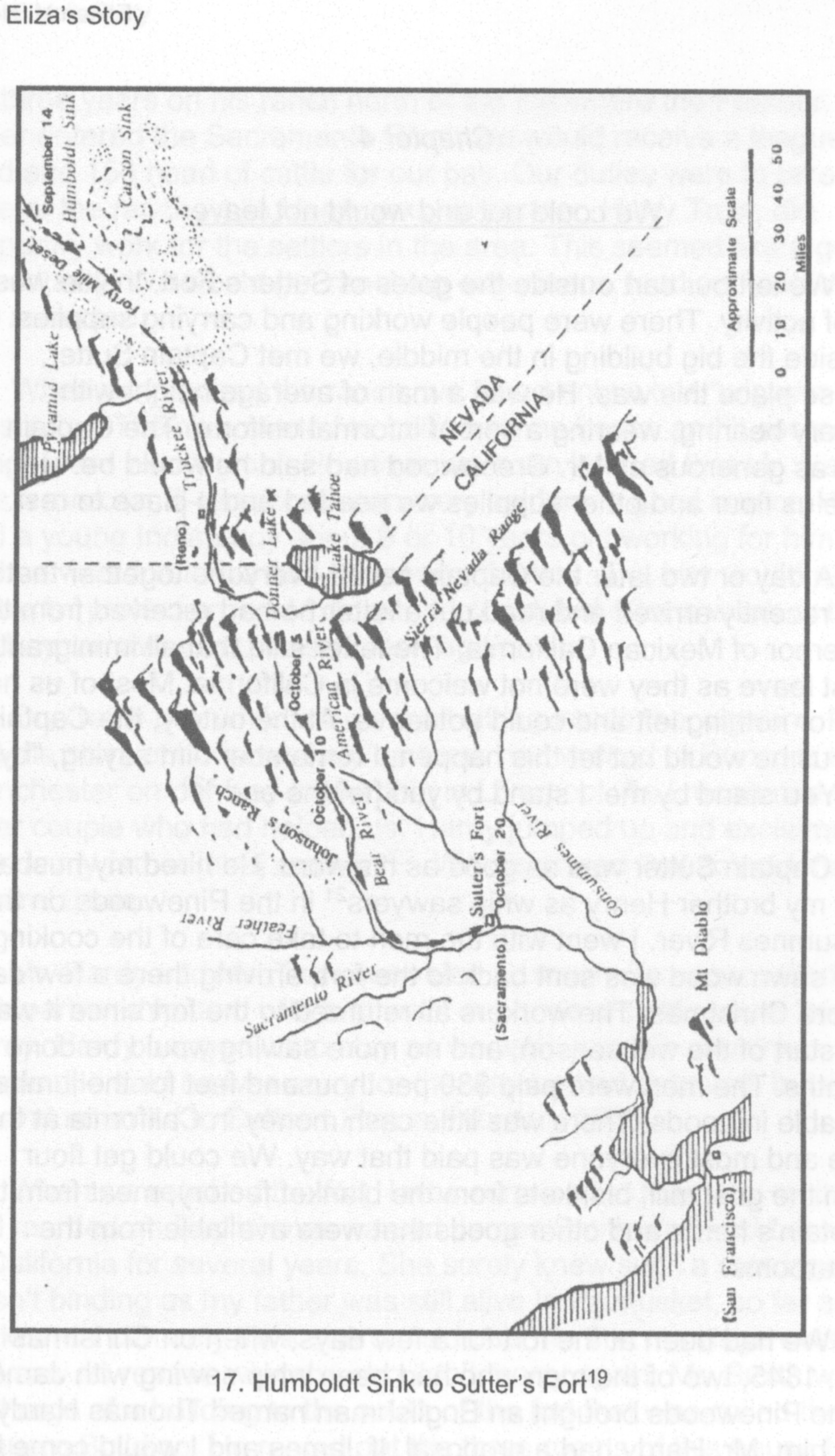Eliza’s Story
Eileen M. Hook 2022 95 pages
Eliza Gregson and her family came to America from England in 1839. In 1845 the family was headed west to California, having been steered from going to Oregon by Caleb Greenwood who had guided the Stephens Murphy Townsend Party the year before. Greenwood convinced the party to change their destination with his description saying, “The road to Oregon was dangerous on account of Indians, and the road to California had an easy grade and crossing the mountains would not be difficult.” Of course later evidence said something else, “When the train arrived at the Sierra though, it was another story, When we looked for the trail, all we could see ahead was a wall of rock as high as the sky. We knew California was on the other side, but the rocks looked insurmountable.”
This book is Eliza’s story, written later in life, with additions from her husband’s “statement” which he’d made to historians also told later in life. It includes lots of pictures and maps. It should be noted here that Eliza and family went over Donner Summit which gives her an eligibility for inclusion in the Heirloom.
Eliza’s Story is an interesting one as we learn a lot about 19th Century life both in England, going across America, and in California.
In England we hear about debtors, collection, and travel. Crossing the continent there are a lot of details: daily activities, crossing streams and rivers, the disadvantages of being at the rear of a wagon train and looking for wood and grass, lack of firewood and using buffalo chips instead, how to go steeply downhill, landmarks (e.g. Chimney Rock), Indians, and of course crossing Donner Summit.
Eliza described wagon train life as,
“We had as good traveling as could be expected A good deal of the trip west was routine, much like life on a farm. At daylight cows were milked, stock was checked, and breakfast was prepared. After breakfast we packed up the wagons, hitched the oxen and started out. Around noon we'd stop and rest for an hour or so and eat the midday meal that we had set aside when breakfast was made. Then we moved on until around 5 PM, or when a suitable camping place was found. The wagons were circled for protection and the oxen unhitched and watered. After supper the cows were milked, and the stock herded either within the circle of the wagons or nearby with guards. The guard was set for the night and changed every two hours until sunrise. Then we'd do it all over again. Day after day, after day, after day.”
On getting to the Sierra crossing:
“There was nothing for it, we had to climb over the Sierra Nevada to reach the valley of California. We all helped empty the wagons and the men took them apart. The pieces were dragged up and the loads carried around the hard stretches. Where the oxen could not climb up, they were dragged up with bleeding shins. After we reached the summit, we were glad to rest a couple of days. Another day of walking and dragging things over rocks got us to a beautiful lake where we camped again.”
Upon arrival in California we hear about daily life and Eliza’s experiences. We also learn about the larger events: Fremont’s arrival, the Bear Flat Revolt, war with Mexico, the capture of General Vallejo, and even the Donner Party with a slightly different perspective from the one we ordinarily see (see the sidebar here). Eliza’s emphasis and especially the last sentence give us an insight, perhaps, into her character in addition to that which we obtained reading of the different episodes of her California life. Life was hard for emigrants. There is one interesting little event that says something about California life and Eliza’s personality, Her husband got very sick with Sacramento Fever. The doctor said Eliza’s husband would die but Eliza didn’t take his word for it. She consulted a friend who had knowledge of herbs but she “didn’t know what to do any more than I did.” So Eliza went out looking for “anything that might help” in the field. Unfortunately the cattle had eaten everything. Eliza reasoned that the cattle must have eaten anything useful and some of what was useful must have gone into cattle manure. “why shouldn’y the manure make a good medicine?” So she wrapped some manure in cloth and boiled it. Eliza’s husband was leery of the stuff but tried it, fell asleep, and woke up weak but cured.
Donner Party sidebar
“Small parties of survivors staggered into the fort, barely more than skeletons. Of the 18 that came out in the first party there were five women and girls amongst them, and we did all in our power for them. I will never forget the looks of those people. Most of them looked crazy and their eyes danced and sparkled in their heads like stars. One woman, Mrs. Fosdick, was truly courageous. She told how the women took the lead over the snow and made a track for the men to walk in. The women took the men by the hand, made the campfires, and doled out the little food they had left. One morning Mrs. Fosdick knew her husband was dying and stayed with him while the rest went ahead. After he passed, she put his black silk neckerchief around her neck and left him in the snow. When she reached the rest of the people, she told them her husband was dead. One of the men asked if they would have him to eat. She said, ‘You cannot hurt him now.’ Some of them went back and brought some of his flesh and cooked and ate it. Some people say women are weak and ought to have no rights. I would not call Mrs. Fosdick weak.”


